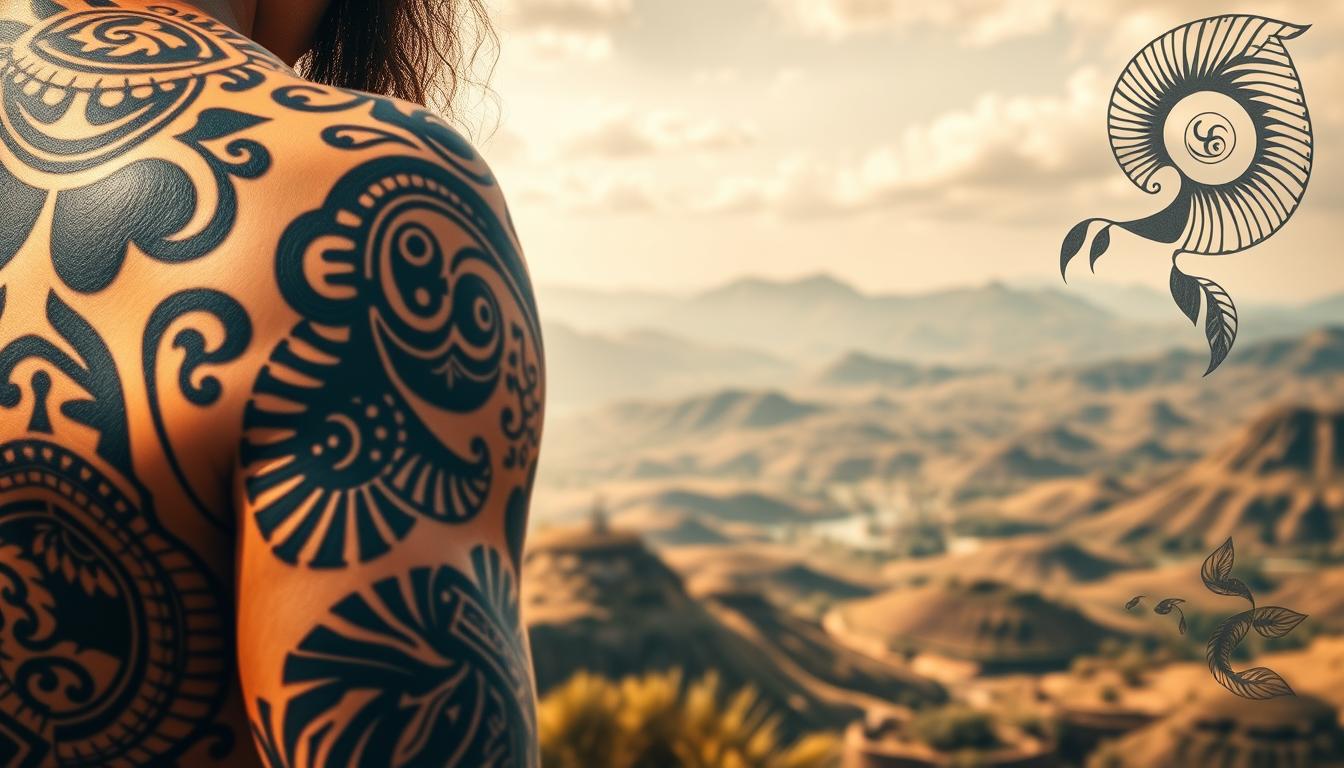
What if your tattoo connects you to a 5,000-year-old tradition? Body art isn’t just a modern trend—it’s a thread woven through the fabric of human history. From therapeutic rituals to symbols of rebellion, inked skin tells stories older than written language.
Imagine walking through bustling markets in ancient Egypt or standing beside Polynesian navigators. In these cultures, markings weren’t decorations—they held power. Shamans used them for healing. Warriors displayed them as badges of honor. Even today, every design carries echoes of these global roots.
You’ll see how societies celebrated art on skin while others feared it. Some saw tattoos as sacred. Others banned them entirely. This push-and-pull shaped their role across continents and centuries.
Modern ink lovers share more with ancestors than they realize. That sleeve? It’s part of humanity’s oldest gallery. That minimalist symbol? It follows patterns carved into Ice Age figurines. Your choices today continue a legacy older than the Great Wall or the Pyramids.
Key Takeaways
- Tattoos date back over 5,000 years across multiple civilizations
- Body art served medical, spiritual, and social purposes historically
- Cultural attitudes shifted between reverence and prohibition
- Global traditions influence modern tattoo styles and meanings
- Contemporary designs maintain links to ancient symbolism
Exploring Ancient Beginnings of Tattooing
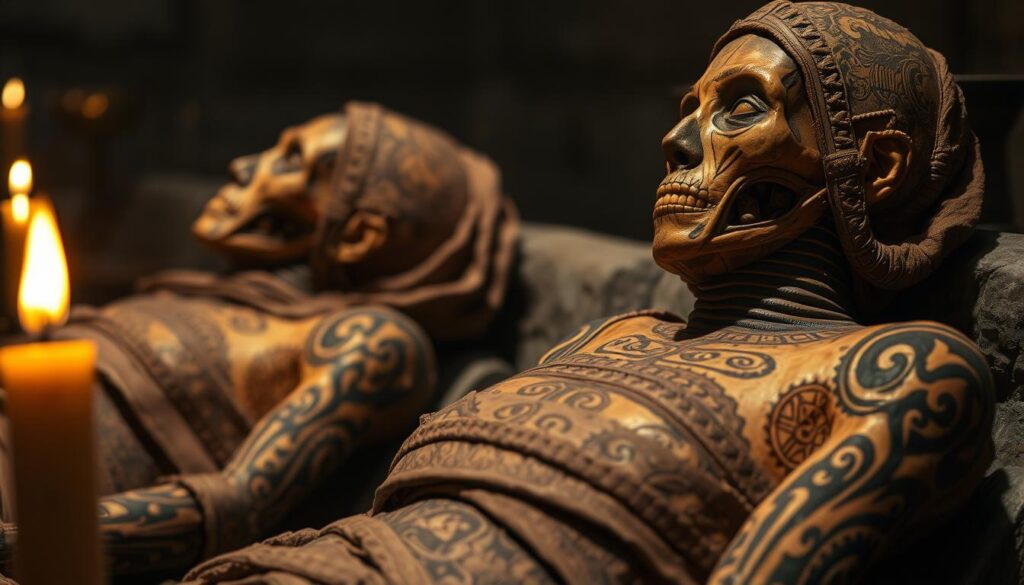
Your modern body art shares DNA with 5,000-year-old skin markings. Researchers uncovered this connection through preserved remains and artifacts that rewrite what we know about early human expression.
Early Evidence on Mummies and Ötzi the Iceman
Scientists found Ötzi the Iceman’s body in 1991, frozen in the Alps. His 57 ancient tattoos—dots and lines—cluster near joints affected by arthritis. “These markings weren’t decorative,” notes one researcher. “They match acupuncture points used to relieve pain.”
Egyptian mummies tell a similar story. A pair from 3100 B.C. bears abstract patterns on their skin. These discoveries prove tattooing spanned continents over five millennia.
| Individual | Age (Years) | Tattoo Count | Purpose | Pigment |
|---|---|---|---|---|
| Ötzi the Iceman | 5,300 | 57 | Therapeutic | Charcoal |
| Egyptian Mummies | 5,100 | Multiple | Cultural | Soot |
The Role of Body Art in Prehistoric Cultures
Long before needles, people pressed pigment into skin using sharpened bone or stone. Japanese clay figurines from 5000 B.C. feature engraved facial marks—early blueprints for symbolic designs.
These findings reveal a global tradition. From Siberia to Chile, mummies found with ink show body modification was more than decoration. It communicated status, healed ailments, and connected communities.
When Were Tattoos Invented?
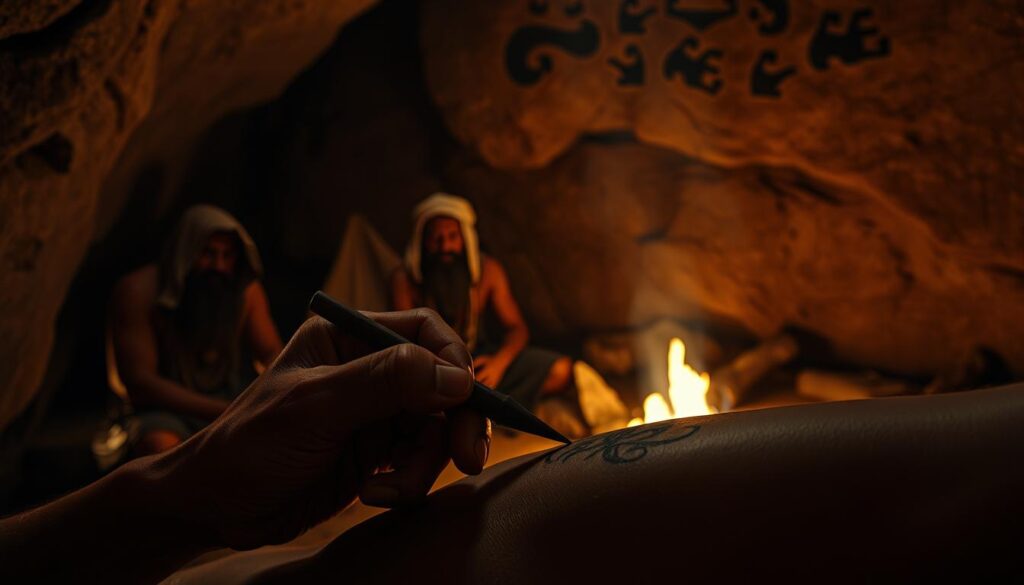
Body art might be humanity’s oldest form of self-expression. Science keeps pushing the origins further back—beyond mummies and into the shadows of prehistory. Researchers suggest skin markings existed before farming or written language.
Scientific Insights and Archaeological Findings
Concrete proof comes from 5,000-year-old Japanese clay figures with etched patterns. But experts argue this represents a developed tradition, not its start. “We’re seeing the tail end of a practice that began thousands of years earlier,” explains one anthropologist.
| Location | Time Period | Evidence Type | Materials Used |
|---|---|---|---|
| Japan | 5000 BCE | Figurine engravings | Clay markings |
| Siberia | 3000 BCE | Preserved skin | Plant-based dyes |
| Egypt | 3100 BCE | Mummy patterns | Soot mixtures |
Charles Darwin noted in 1871:
“No nation exists that doesn’t practice tattooing or similar body decoration.”
This universal impulse suggests multiple origins. If we found older preserved remains, scientists believe they’d show similar markings. Your love for ink connects you to countless generations who turned skin into story.
The true beginning remains hidden. But each new discovery adds chapters to a 10,000-year saga written in ash and ochre. What we call modern body modification is really ancient tradition wearing new colors.
Discovering Tattoo Techniques and Tools Through Time
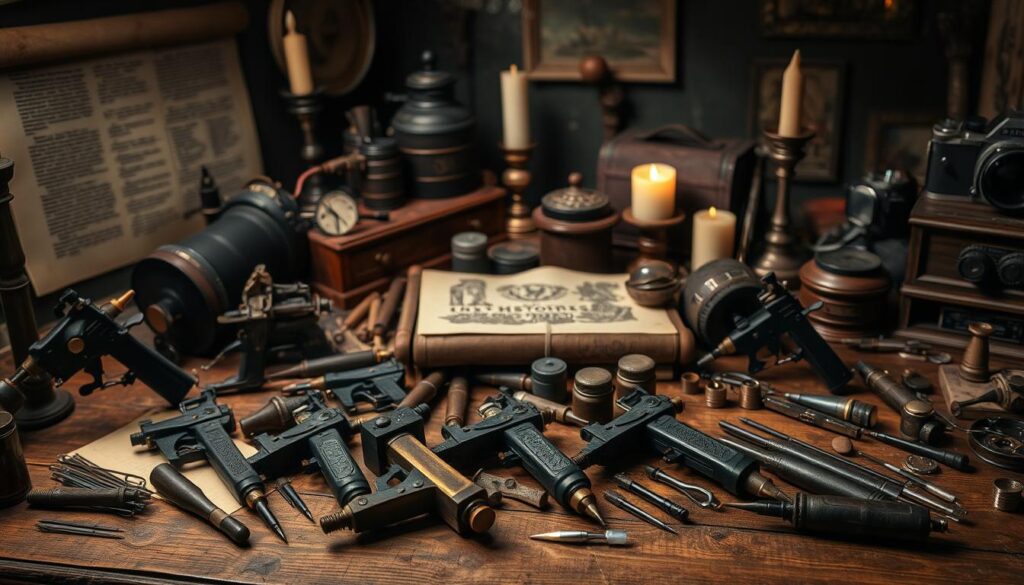
The journey from bone needles to electric machines reveals humanity’s ingenuity. Ancient artists turned natural materials into precision tools, creating body art that still inspires today’s tattoo designs. Let’s explore how these methods shaped cultural practices across millennia.
Early Methods and Materials Used in Tattooing
Imagine pressing cactus spines into skin to create permanent patterns. The Chancay culture did exactly this 1,000 years ago, using sharpened animal bones for intricate geometric shapes. Researchers found floral motifs and interlocking triangles preserved on ancient remains.
Samoan artists perfected handheld “combs” from boar tusks. These tools featured serrated edges attached to turtle shells and wooden handles. By tapping the comb with a mallet, they drove natural pigments deep into the body—a technique still used in traditional tatau ceremonies.
| Culture | Tools | Pigments | Design Style |
|---|---|---|---|
| Chancay | Cactus needles, animal bones | Plant-based dyes | Geometric patterns |
| Samoan | Bone combs, turtle shells | Burnt candlenut soot | Bold tribal motifs |
| Modern | Electric machines | Synthetic inks | Diverse styles |
Early ink recipes mixed soot, charcoal, and plant extracts with liquids like sugar water. These formulas created lasting colors without modern chemicals. By 1891, Samuel O’Reilly transformed Thomas Edison’s electric pen into the first modern tattoo machine—revolutionizing speed and precision.
Today’s sterile equipment and vibrant inks build on 5,000 years of experimentation. Your tattoo artist’s needle shares DNA with tools that once carried spiritual power. Every line etched into your skin continues a global story of creativity.
Cultural Rituals and Symbolism in Ancient Tattooing
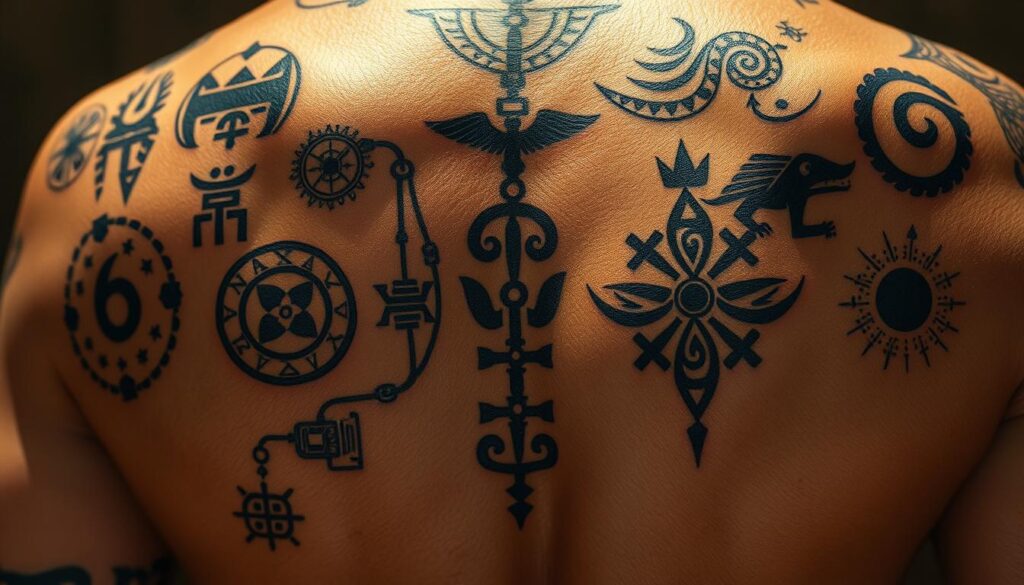
Skin became humanity’s first canvas long before paint touched cave walls. Permanent markings carried coded messages about status, spiritual beliefs, and community roles. These living symbols transformed bodies into walking histories.
Tattoos as Marks of Status, Rituals, and Identity
Warriors in Borneo earned hand tattoos after taking heads in battle. Japanese aristocrats wore subtle facial marks denoting royal lineage. Each culture developed its visual language:
- Polynesian chiefs displayed full-body patterns showing leadership
- Egyptian priestesses bore hip markings for fertility rites
- Scythian nomads used animal motifs to honor deities
Coming-of-age ceremonies often included permanent symbols. Maori youth received facial moko after proving adulthood. These patterns served as both personal ID and family history.
The Dual Nature of Tattoos: Therapeutic and Punitive Uses
Ötzi’s 57 dots matched acupuncture points for joint pain relief. Meanwhile, Roman law branded criminals with forehead letters. This contrast shows body art’s complex role:
| Culture | Purpose | Symbols | Body Location |
|---|---|---|---|
| Ancient Greece | Slave identification | Ownership marks | Face/Hands |
| Feudal Japan | Criminal punishment | Incremental lines | Forearm |
| Incan Empire | Medical treatment | Geometric grids | Pain areas |
Some societies saw skin as sacred parchment. Others treated it like wanted posters. Your ink choices today still navigate this ancient tension between celebration and control.
Tattooing in Myth, Medicine, and Mysticism

Imagine symbols etched into skin serving as both medical charts and sacred texts. This dual purpose defined ancient Egyptian body modification, where spiritual beliefs and healing practices merged under the needle.
Acupuncture and Therapeutic Theories in Early Practices
Scientists discovered women in ancient Egypt received intricate dot patterns across their torsos. These net-like designs weren’t decorative—they marked pressure points believed to protect during pregnancy. “The placement matches areas associated with childbirth,” explains archaeologist Jana Jones. “This practice tattooing combined physical care with magical safeguards.”
One remarkable example comes from Deir el-Medina. A mummified woman bears sacred symbols linking her to goddess Hathor—lotus flowers on her shoulders, divine cows along her back. Researchers suggest she might have served as a living temple, her tattoo art channeling divine energy.
Three key reasons drove these permanent markings:
- Physical protection through strategic placement
- Spiritual connection to deities
- Social identification as healers or priestesses
This blend of medicine and mysticism shows how early cultures saw skin as permeable to both disease and divinity. Your modern interest in meaningful body art echoes their belief that marks could heal souls while treating bodies.
Tattooing Across World Cultures
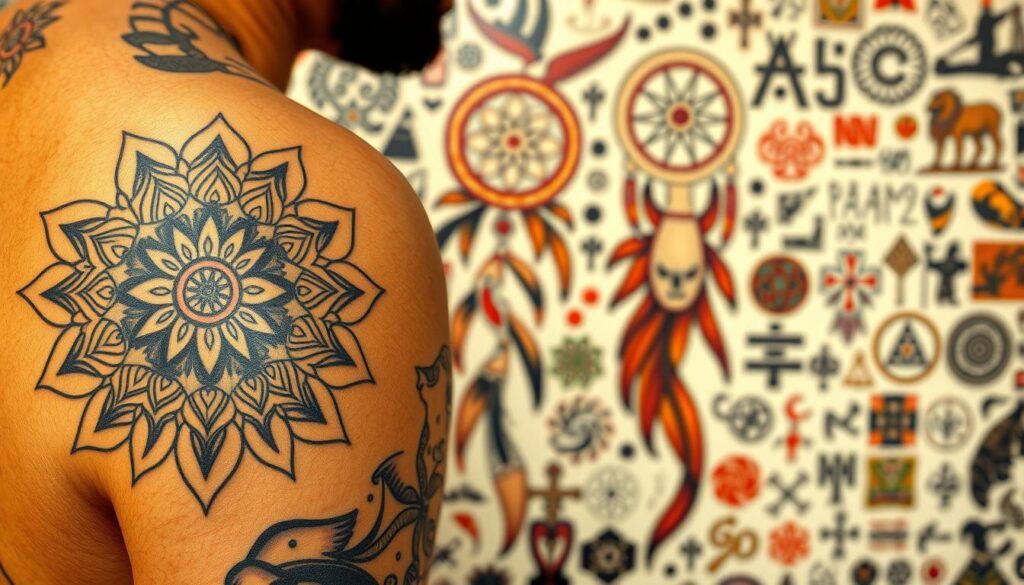
Your skin could be reading an ancient map of human connection. Charles Darwin observed this universal impulse, noting cultures worldwide practiced permanent body art. From tropical islands to frozen tundras, people turned their bodies into living records of identity and belief.
Island Traditions: Symbols Etched in Skin
The Samoan tatau ceremony gave us the English word “tattoo.” Warriors earned intricate patterns showing courage and community ties. Maori leaders wore facial designs called moko—chiseled marks declaring lineage and status. Women’s chin patterns held different meanings, often signaling life stages.
Similar practices emerged oceans apart. Arctic women and Northwest Coast tribes developed matching cheek markings. Southeast Asian men wore full-leg tattoos resembling woven trousers. These parallel traditions prove our shared need to mark milestones.
Mediterranean Marks: From Sacred to Scarred
Egyptian priestesses bore hip designs linking them to fertility goddesses. Greek slaves carried ownership symbols on their faces. Romans took a darker approach:
| Culture | Purpose | Body Area |
|---|---|---|
| Egyptian | Spiritual connection | Hips/Shoulders |
| Greek | Slave identification | Forehead/Hands |
| Roman | Criminal punishment | Forearms |
These cultures show body art’s dual nature—revered by some, weaponized by others. Your modern ink choices still navigate this complex history, blending ancient symbolism with personal meaning.
Modern Tattoo Evolution and Aftercare
The buzzing tattoo machine hides a secret—it’s part of a 175-year American legacy. Over one-third of U.S. adults now wear body art, transforming what sailors and circus performers once used as identity markers into mainstream self-expression.
Martin Hildebrandt’s 1846 New York studio started it all. His hand-poked methods evolved into today’s precision tools. Sterile needles and hypoallergenic inks now let many people get tattoos safely—a far cry from early 20th-century practices.
Skin Safety Meets Artistic Innovation
Modern studios follow strict health codes. Single-use needles and autoclave sterilization prevent infections. Vibrant pigments last decades, while aftercare products help tattoo designs stay crisp. Your artist’s license? It’s backed by centuries of trial and error.
Keeping Your Ink Timeless
Fresh tattoos need gentle care. Clean with fragrance-free soap. Moisturize using ointments without petroleum. Avoid sun exposure for three weeks—UV rays fade colors faster. Proper healing ensures your art remains as bold as the day you got it.
From underground symbols to celebrated art forms, body markings continue evolving. Each new design writes another line in humanity’s oldest storybook—one that’s literally skin-deep.
